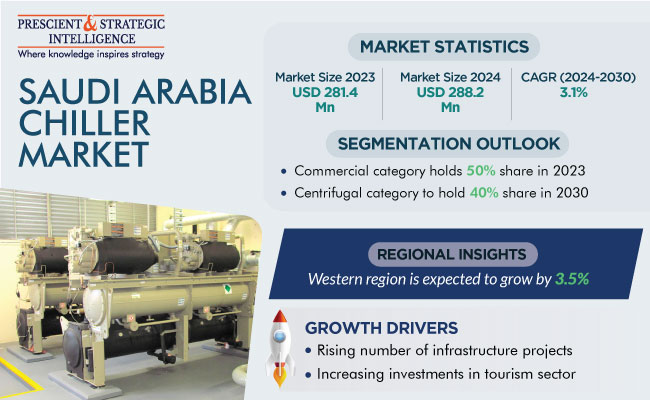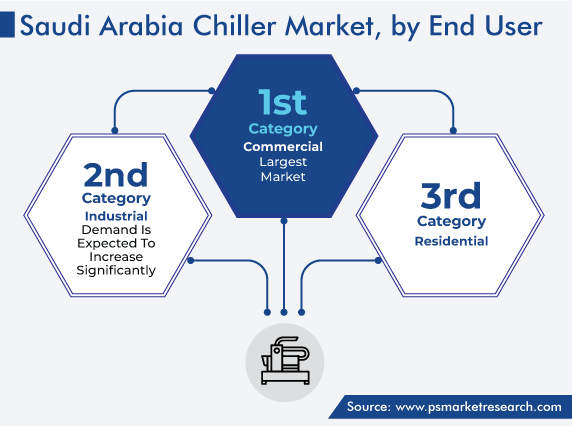Report Code: 11651 | Available Format: PDF | Pages: 190
Saudi Arabia Chiller Market Size and Share Analysis by Chiller Type (Screw, Scroll, Absorption, Centrifugal, Reciprocating), End User (Commercial, Industrial, Residential) - Industry Demand Forecast to 2030
- Report Code: 11651
- Available Format: PDF
- Pages: 190
- Report Description
- Table of Contents
- Market Segmentation
- Request Free Sample
Market Overview
The Saudi Arabia chiller market size was valued at USD 281.4 million in 2023, and it is expected to reach USD 346.3 million by 2030, exhibiting a CAGR of 3.1% during the forecast period (2024–2030). This is ascribed to the rising number of infrastructural projects, the increasing investment in the tourism sector, the expansion of the hospitality industry, and the surging annual temperature in the country.
The number of infrastructural projects is rising in the country. This is because the government is actively taking part and involved in the development of infrastructure, which leads to an increased demand for cooling systems, especially chillers, in various areas such as supermarkets, metro stations, and buildings. For instance, the Qiddiya project is currently under development with the vision of becoming a comprehensive city dedicated to entertainment, sports, and the arts. The first phase of the project was already completed in 2022, with an initial investment of USD 8 billion. Also, it will reach its target of 17 million visitors annually by 2035.

Moreover, the expansion of the tourism sector has accelerated the growth of the Saudi chiller market. Tourism has gained a key place in Saudi Arabia’s vision for 2030. For instance, the country's revenue from tourism reached more than tripled in the first quarter of 2023 to 37 billion Saudi Riyals ($9.86 billion), as the Kingdom seeks to attract more foreign visitors and diversify its economy.
In addition, during the initial three months of 2023, the Kingdom of Saudi Arabia welcomed approximately 7.8 million tourists, achieving its highest quarterly performance to date. This figure reflects a substantial 64% increase compared to the previous year. The boost in tourism revenue has enabled the country to record a surplus in the balance of payments for the tourism sector during the first quarter, totalling 22.8 billion Riyals. Thus, this factor drives the demand for chillers in the country.
Furthermore, the food and beverage industry uses chillers for storing food at a constant temperature; therefore, chillers are important for cooling wine, beer, soft drinks, and other food items. Additionally, due to its deserted environment and limited agriculture potential, Saudi Arabia relies heavily on imports, and approximately 80% of edible items and food products in this sector depend on imports, which need to be stored well using chillers. Thus, this leads to an increase in the sales of chillers in Saudi Arabia.
Centrifugal Chillers Dominate the Market
Based on type, the market is categorized into centrifugal, screw, scroll, absorption, and reciprocating chillers. Among these, the centrifugal category holds the largest share. This is attributed to its major deployment of space cooling systems in large manufacturing plants, the oil and gas sector, and commercial spaces such as airports and metro stations. Further, the increasing number of infrastructure developments is driving the demand.
| Report Attribute | Details |
Market Size in 2023 |
USD 281.4 Million |
Market Size in 2024 |
USD 288.2 Million |
Revenue Forecast in 2030 |
USD 346.3 Million |
Growth Rate |
3.1% CAGR |
Historical Years |
2017-2023 |
Forecast Years |
2024-2030 |
Report Scope |
Market Trends, Drivers, and Restraints; Revenue Estimation and Forecast; Segmentation Analysis; Impact of COVID-19; Companies’ Strategic Developments; Market Share Analysis of Key Players; Company Profiling |
Segments Covered |
By Chiller Type; By End Use; By Region |
Explore more about this report - Request free sample
Commercial Chillers Witness Massive Growth in Demand
Based on end use, the commercial category is expected to witness the fastest growth in the market. This can be due to the rise in the number of offices and buildings, the expansion in the hospitality and tourism sectors, and the rise in infrastructure investment of the nation. Also, the leading growth of the commercial sector, tourism-affiliated projects, and transportation sector is led by event preparations, which evaluated the value for evolution, which is in billions. Therefore, the growth of the construction industry is forecasted to be a prime component for the development of the market.
For instance, under the commercial sector, the Kingdom initiated its digital tourism strategy, which is a map-out to distribute the next move of the expansion and development of the sector and expedite progress with regard to the objectives of the National Tourism Strategy. This strategy focuses on executing agile digital and technology procedures all around the sector in order to furnish tourists and stakeholders with a more logical experience.
The focus of the strategy is on a number of areas, which include encouraging the Kingdom-wide culture of modernization and future-proof regulations, developing new digital business models to raise the demands of service providers, and upskilling and reskilling the country's tourism workforce. The nine programs consist of the strategy and 31 initiatives that are set to be executed over a duration of 3 years. Moreover, the Entrepreneurship Middle East report suggested that by 2030, 50% of tourists are forecasted to visit for leisure, 32% for religious tourism, 10% for visiting friends and families (VFR), and 9% for business tourism.

Western Region Market Is Growing at the Highest Rate
Based on region, the market is categorized into western, central, eastern, and southern. Out of which, the chiller market in western Saudi Arabia is projected to record the fastest growth in the forecasted years. This can be because the region is home to historical and cultural landmarks like Al-Ula, as well as stunning natural landscapes like the Red Sea coast and the Asir Mountains.
Moreover, Saudi Arabia has been actively pursuing economic diversification through its Vision 2030 program. Western Saudi Arabia can contribute to this goal by developing a diverse economy that goes beyond traditional sectors like oil and gas. This can include investments in industries such as tourism, renewable energy, and infrastructure, ultimately leading to growth in the Saudi Arabia chiller market.
In addition, the surging investments in infrastructure, hospitality, and tourism services can help attract both domestic and international tourists. Also, infrastructure developments such as building modern infrastructure, including transportation networks, airports, and ports, are crucial for the region's growth. This helps improve connectivity, which can facilitate trade, tourism, and business activities.
Some of the Key Players in the Market Are:
- Ingersoll-Rand plc
- United Technologies Corporation
- Daikin Industries Ltd.
- Petra Engineering Industries Co.
- Zamil Air Conditioners
- Gree Electric Appliances
- Mitsubishi Electric Corporation
- Thermax Limited
Market Size Breakdown by Segment
This report offers deep insights into the Saudi Arabia chiller market, with size estimation for 2017 to 2030, the major drivers, restraints, trends and opportunities, and competitor analysis.
Based on Chiller Type
- Screw
- Water-cooled
- Air-cooled
- Scroll
- Water-cooled
- Air-cooled
- Absorption
- Steam
- Hot-water
- Direct-fired
- Centrifugal
- Reciprocating
- Water-cooled
- Air-cooled
Based on End User
- Commercial
- Transportation
- Hospitality
- Healthcare
- Retail
- Corporate
- Government
- Industrial
- Chemical
- Food and beverages
- Pharmaceuticals
- Automotive
- Energy and utilities
- Oil and gas
- Residential
Geographical Analysis
- Central
- Western
- Eastern
- Southern
The Saudi Arabia chiller market size stood at USD 281.4 million in 2023.
During 2024–2030, the growth rate of the Saudi Arabia chiller market will be around 3.1%.
Commercial is the largest end user in the Saudi Arabia chiller market.
The major drivers of the Saudi Arabia chiller market include the surging number of infrastructural projects, the growing tourism and hospitality industries, and the government actively taking part and increasing investment in the development of infrastructure.
Want a report tailored exactly to your business strategy?
Request CustomizationWant an insight-rich discussion with the report author?
Speak to AnalystOur dedication to providing the most-accurate market information has earned us verification by Dun & Bradstreet (D&B). We strive for quality checking of the highest level to enable data-driven decision making for you
Our insights into the minutest levels of the markets, including the latest trends and competitive landscape, give you all the answers you need to take your business to new heights
With 24/7 research support, we ensure that the wheels of your business never stop turning. Don’t let time stand in your way. Get all your queries answered with a simple phone call or email, as and when required
We take a cautious approach to protecting your personal and confidential information. Trust is the strongest bond that connects us and our clients, and trust we build by complying with all international and domestic data protection and privacy laws